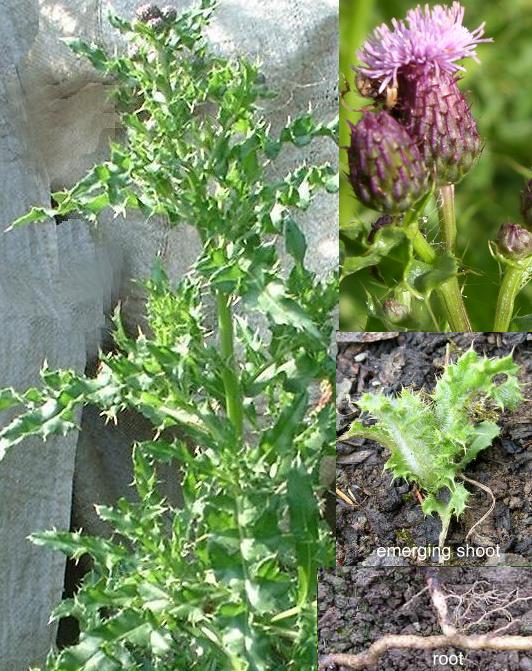Creeping thistleScientific Name: Cirsium arvense |
Perennial weed found in grassland and perennial crops like orchards, spreading by deep, white, fleshy roots and by seed. There are male and female plants (dioecious), the former having spherical flowers and the latter elongated. The leaves have sharp spines along their wavy, lobed edges. The plant can be up to 100cm high and does not have spines on the stem.
It is a native of Eurasia and North Africa, but has been introduced to North America and Australia, probably by accidental transport of the seed.
The flowers are lilac or pale purple, appearing from July to September. The plants need to be within 100m of each other for pollination to occur. When ripe the seeds are wind-borne on fluffy balls of long hairs (pappus) and germinate the same year or the following spring. The flowering stem dies back when the seeds mature, but remains upright to disperse them.
The seedling develops a long tap root which can go down about 3 metres and lateral roots which can spread for up to 6 metres. These lateral roots develop adventitious buds which grow in the spring.
It is proscribed under the Weeds Act 1959 and must be controlled in agricultural land. Allowing the seed to disperse is an offence.
Remove the young plants before they can develop a perennial root system. For established plants, dig out as much root as possible, repeat many times. Breaking up the roots can result in multiplying the problem, unless they are brought to the surface where drying or frost will kill them. Also the roots can lie dormant in the ground for many years. Pulling the mature thistles or close mowing for a few years can greatly reduce their vigour and provided it is a isolated patch, they will die out eventually.
Weedkillers to use:-
Glyphosate, systemic action, taken down into
underground parts.
Dichlobenil (now banned by EU regulations) applied in early spring, kills emerging shoots for
up to a year among established woody plants.
The Spear Thistle is a larger plant with more vicious spines, but does not have creeping roots, and is similarly controlled by the Weeds Act. see also the Marsh Thistle.
